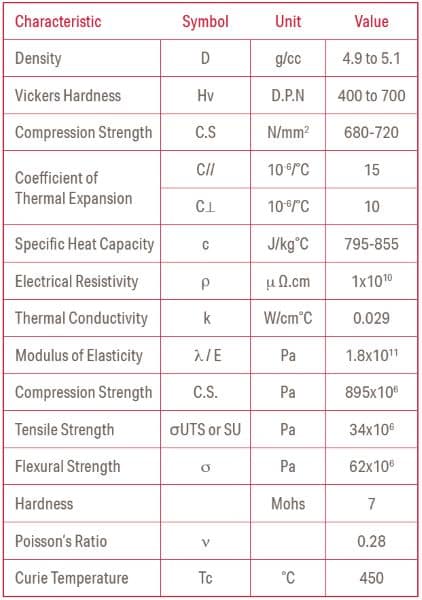Characteristics of Ferrite Magnets
The Original Online Company
This section provides information of the physical properties of Ferrite Permanent Magnets
Ferrite permanent magnets have good machining properties which allows them to be cut into different shapes and sizes – they are cut with diamond tooling; standard drills and wire spark erosion techniques do not work (they are electrically insulating so current does not pass through them due to their extremely high electrical resistance, hence their other name of Ceramic Magnets).
Ferrite magnets are made by wet or dry pressing and sometimes by extrusion. Wet pressing gives stronger magnetic properties (e.g. Ferrite C8). Dry pressing gives improved dimensional tolerances (e.g. Ferrite C5). The magnets are then sintered to fuse the powder together and are then machined to final shape. The extrusion method can be applied to produce arc segment shapes which are then cut to length. Sometimes new tooling is required to produce the ferrite magnets if existing tooling does not allow the shape to be produced. Typical tolerances for ferrite magnets are +/-0.25mm although +/-3% is also used.
When Ferrite magnets get hotter, their high intrinsic coercivity actually improves (improving resistance to demagnetisation) making them extremely popular in motor and generator designs and also in loudspeaker applications (only ferrite magnets become noticeably more resistant to demagnetisation when heated). Ferrite magnets have a positive temperature coefficient of Intrinsic Coercivity (it changes by +0.27 %/deg C from ambient) and only ferrite shows this amount of this characteristic. However the magnetic output does fall with temperature (it has a negative temperature coefficient of Induction of -0.2 %/degC from ambient). The end result is that Ferrite magnets (ceramic magnets) can be used at high temperature with very few issues.
Ferrite magnets can be used up to +250 degrees C (and in some cases up to +300 deg C) making it ideal for use in electrical machines and most high temperature applications. At sub-zero temperatures e.g. less than -10 to -20 deg C, ferrite magnets may start to show a reduced pull force (the temperature and the degree of weakening depends on the magnet shape and is application specific; in most applications the temperature of operation is not low enough for this effect to happen). This is because if its +0.27 %/deg C temperature coefficient of Intrinsic Coercivity – the Hci falls as the magnet gets colder. Ferrite can demagnetise if put in too cold an environment but it is the total magnetic circuit design that determines how cold the magnet must be before any weakening is noted (e.g. operating at temperatures as low as -60 deg C is possible with careful design).
The ferrite grades have physical properties which are similar between the grades. Below is an overview of these properties:
Summary of Physical Properties of Ferrite magnets / Ceramic magnets

Temperature characteristics of Ferrite Magnets
|
MAGNET |
Rev.Temp.Coef. of Induction |
Rev.Temp.Coef. of Coercivity |
Max. Working Temperature |
|
(based on High working point) |
|||
|
Ferrite |
-0.2 |
+0.27 |
300 ºC = 572 ºF |
Structural use of Ferrite / Ceramic magnets
There is a risk of chipping or breaking the magnets because all magnets are inherently brittle. It is advised to not put magnets in conditions of mechanical stress e.g. in load bearing situations. Like all magnets, because ferrite is brittle it should not be exposed to high compressive forces.
Ferrite / Ceramic magnets and corrosion resistance
Because the material within the magnet material is already in oxide forms, it cannot be oxidized further. Therefore ferrite / ceramic magnet have superb corrosion resistance. Water and salt water have no effect at all on ferrite magnets – they simply will not rust (in simplified terms, ferrite magnets contains iron oxide, which is what rust is!).
Discover More
Get in touch today
Please do not hesitate to contact us with any question or query you may have. Our professional team will give you expert advice and guidance for your magnetic application and equipment.


